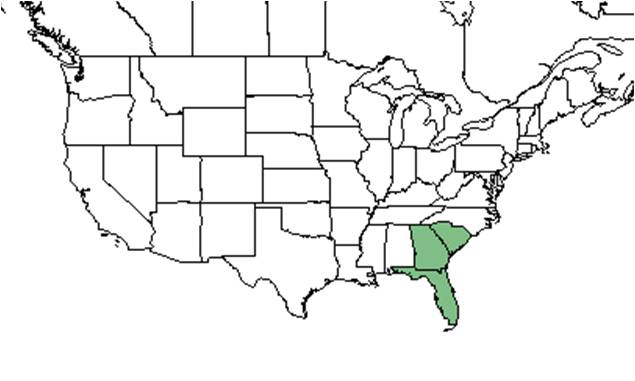Difference between revisions of "Galactia elliottii"
KatieMccoy (talk | contribs) (→Description) |
KatieMccoy (talk | contribs) (→Distribution) |
||
| Line 25: | Line 25: | ||
==Distribution== | ==Distribution== | ||
| + | It is native to South Carolina, Georgia and Florida (Muir and Pitman 1987). | ||
| + | |||
==Ecology== | ==Ecology== | ||
===Habitat=== <!--Natural communities, human disturbed habitats, topography, hydrology, soils, light, fire regime requirements for removal of competition, etc.--> | ===Habitat=== <!--Natural communities, human disturbed habitats, topography, hydrology, soils, light, fire regime requirements for removal of competition, etc.--> | ||
Revision as of 18:07, 15 December 2015
| Galactia elliottii | |
|---|---|

| |
| Scientific classification | |
| Kingdom: | Plantae |
| Division: | Magnoliophyta - Flowering plants |
| Class: | Magnoliopsida - Dicotyledons |
| Order: | Fabales |
| Family: | Fabaceae ⁄ Leguminosae |
| Genus: | Galactia |
| Species: | G. elliottii |
| Binomial name | |
| Galactia elliottii Nutt. | |

| |
| Natural range of Galactia elliottii from USDA NRCS Plants Database. | |
Common name: Elliott's milkpea
Contents
Taxonomic notes
Description
G. elliottii is a perennial, viney, herbacious legume. Leaves are alternate and petiolate with inconspicuous, green stipules [1]. It is a nitrogen fixing plant (Stiling et al. 2003).
Distribution
It is native to South Carolina, Georgia and Florida (Muir and Pitman 1987).
Ecology
Habitat
In the Coastal Plain in Florida, G. elliottii can be found in pine flatwoods and mesic transition zones between scrubs and seepage forests. In human impacted areas it has been found in railroad gravel and in coarse sandy roadsides amongst grasses (FSU Herbarium). Associated species include Croton glandulosus and Sporobolus virginicus (FSU Herbarium).
Phenology
It has been observed fruiting March through May and flowering May and June (FSU Herbarium).
Seed dispersal
Seed bank and germination
Fire ecology
Pollination
The following Hymenoptera families and species were observed visiting flowers of Galactia elliottii at Archbold Biological Station (Deyrup 2015):
Halictidae: Halictus poeyi, Nomia maneei
Megachilidae: Anthidiellum notatum rufomaculatum, Megachile exilis parexilis, M. georgica, M. mendica, M. petulans
Use by animals
Diseases and parasites
Conservation and Management
Cultivation and restoration
Photo Gallery
References and notes
Deyrup, M.A. and N.D. 2015. Database of observations of Hymenoptera visitations to flowers of plants on Archbold Biological Station, Florida, USA.
Florida State University Robert K. Godfrey Herbarium database. URL: http://herbarium.bio.fsu.edu. Last accessed: October 2015. Collectors: Loran C. Anderson, Edwin L. Bridges, R.K. Godfrey, Ed Keppner, Lisa Keppner, Robert A. Norris, Steve L. Orzell. States and Counties: Florida: Bay, Highlands, Nassau, Polk, St. Johns, Taylor, Volusia. Compiled by Tall Timbers Research Station and Land Conservancy.
- ↑ [Encyclopedia of Life]Accessed December 11, 2015